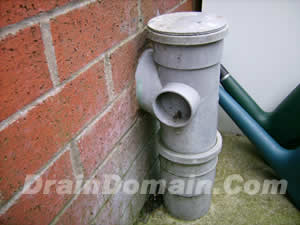Is there any benefit to plastic over prefab concrete?
Access not great so will be a manual effort, being quoted 2-3 days so far
Access not great so will be a manual effort, being quoted 2-3 days so far

Bit concerned about that Circumferential crack in the WC drain at around 2 minutes into the survey, does seem to be a lot of water getting in there. Appreciate the gulley and associated drain is in poor condition, but a gulley is only taking water when an appliance draining to the gulley is discharged. That water has to be coming from somewhere.
Drains need to be fixed, but it could also raise the question of a leaking water service pipe. Judging by the drainage, the age of the property would indicate a lead water service, (and even if the original has been replaced there's no guarantee the old service was disconnected before being abandoned.....)Think without digging it up to see whats going on and the amount of water involved then it's difficult to say further, but certainly wont be the first time an old lead service has been merrily leaking away for many years!
Bit concerned about that Circumferential crack in the WC drain at around 2 minutes into the survey, does seem to be a lot of water getting in there. Appreciate the gulley and associated drain is in poor condition, but a gulley is only taking water when an appliance draining to the gulley is discharged. That water has to be coming from somewhere.
Drains need to be fixed, but it could also raise the question of a leaking water service pipe. Judging by the drainage, the age of the property would indicate a lead water service, (and even if the original has been replaced there's no guarantee the old service was disconnected before being abandoned.....)Think without digging it up to see whats going on and the amount of water involved then it's difficult to say further, but certainly wont be the first time an old lead service has been merrily leaking away for many years!
Funnily enough, as the job is currently in progress and about 2 feet of foundations have been excavated, we have discovered the following:
- the soil pipe vertical drop was indeed inside the house, broken, and leaking
- the gulley clay pot and pipework were wrecked in several places
- alongside the soil pipe is the original lead incoming water main which disappeared right underneath the house. The old gas incomer was also found too, which disppears underneat the bathroom.
I suspect the lead pipe has been capped off in the hallway as the original plans show that a small cupboard was next to the bathroom of the original bungalow. This area has a small amount of damp in it.
The waste pipes/drainage very obviously needed replacing, but the builder is unwilling to cut into the lead pipe (which should be dead..) and frankly i don't blame him, i donly said it in jest.
Is there a way to see if it is live though?
Thanks.
Fingers crossed then there is no old lead services merrily leaking away. I would expect the water to be running constantly if such a leak was present so hopefully it is down the the broken drainage.
If you need to find a tradesperson to get your job done, please try our local search below, or if you are doing it yourself you can find suppliers local to you.
Select the supplier or trade you require, enter your location to begin your search.
Are you a trade or supplier? You can create your listing free at DIYnot Local
